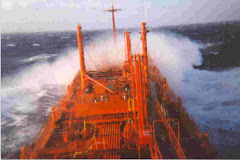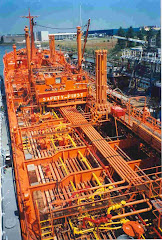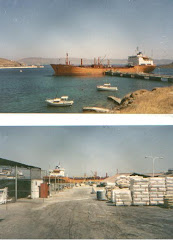Despite the global financial crisis, this year has seen some revival in dry cargo rates, especially for Panamax and Capesize vessels. This has led to some renewed investor interest in the sector, notably by Peter Georgiopoulos. The investment thesis rests on Chinese growth potential. Chinese analysts tend to be more reserved. They see significant barriers to expansion in the hinterland and have mounting concerns over misinvestment and asset bubbles, jeopardizing future financial stability.
Western frenzy over China and its prospects tends to resemble the dot.com enthusiasm of the late 1990's with glowing forecasts of everlasting, insatiable demand. It is true that China is a resource-scarce economy with increasing import needs but there are serious issues of longer-term sustainability.
Whilst China entered the crisis with the highest investment rate in history, there is also very high investment misallocation. The primary source of China's high savings rate is their state owned enterprises (SOE's) that are sustained by energy and land subsidies, cheap credit, low wage costs and lax environmental standards. Without subsidized and controlled interest rates, even ignoring the other subsidies, the most important of which maybe the currency undervaluation, Chinese SOE profits in the aggregate would be negative. There is no guarantee that the current environment of low interest rates and cheap money is indefinitely sustainable.
Most of the cargo demand for larger bulk carriers depends on the steel industry, where iron ore is a major factor. The iron ore market has been brutal for China, partly due to China's own inefficient system. China imports more ore than Europe and Japan combined. Skyrocketing prices have cost China dearly.
For four decades before 2003, fine iron ore prices fluctuated between US$ 20 and US$ 30 a ton. As ore was plentiful, prices were driven by production costs. After 2003, Chinese demand drove prices out of this range. Contract prices quadrupled to nearly US$ 100 per ton, and the spot price reached nearly US$ 200 a ton in 2008. The gradual concentration of major iron ore mines by the world's three largest suppliers was a major reason for this price increase. The nature of Chinese demand was another major reason. China's steel production capacity has skyrocketed, even though capacity is fragmented.
China's local governments have been obsessed with promoting steel industry growth, which is the reason for fragmentation. Huge demand and numerous small players are a perfect setup for price increases by the Big Three miners, which often cite high spot prices as the reason for jagging up contract prices. But the spot market is relatively small, and mines can easily manipulate spot prices by reducing supply. On the other hand, numerous Chinese steel mills simultaneously want to buy ore to sustain production so their governments can report higher GDP rates, even if higher GDP is money-losing. China's steel industry is structured to hurt China's best interests.
The Chinese government is very much wedded to it’s 8% growth target and will do whatever it takes to come close to that target – including flooding the domestic banks with a wall of cheap money to lend as economic stimulus. However, preventing a downturn with easy money is a dangerous way to reflate the economy.
As profitability for the businesses that serve the real economy remain weak, there has been of shift of investment in the first half of 2009 disproportionately into property, stock and commodity markets rather than private sector capital formation. This shift in the medium term threatens to undermine China’s financial stability. Thus, China is experiencing a relatively weak real economy and red hot asset markets.
The Chinese imports that revived the bulk carrier market this year were mostly for speculative inventories. Bank loans were so cheap and easy to get that many commodity distributors used financing for speculation. The first wave of purchases was to arbitrage the difference between spot and futures prices. That was smart. But now that price curves have flattened for most commodities, these imports are based on speculation that prices will increase. Demand from China's army of speculators is driving up prices, making their expectations self-fulfilling in the short term.
Even more foreboding is a looming real estate bubble. The real estate sector in China is especially critical to the bulk carrier market because approximately 50% of Chinese demand for steel is generated by the construction industry. Most Western shipping forecasts are based on unlimited future need in China for new construction. The reality is quite different. China’s urban living space is 28 square meters per person, quite high by international standard. China’s urbanization is about 50%. It could rise to 70-75%. Afterwards the rural population would decline on its own due to its high average age.
So China’s urban population may rise by another 300 million people. If we assume they all can afford property (a laughable notion at today’s price), Chinese cities may need an additional 8.4 billion square meters. China’s work-in-progress is over 2 billion square meters. There is enough land out there for another 2. The construction industry has production capacity of about 1.5 billion square meters per annum. Absolute oversupply, i.e., there are not enough people for all the buildings, could happen quite soon.
The most basic approach in studying bubbles is to look at valuation. For property the most important measures are price to income ratio and rental yield. China’s average price per square meter nationwide is quite close to the average in the US. Yet the US’s per capita income is seven times China’s urban per capita income. The nationwide average price is about three months of salary per square meter, probably the highest in the world! Consequently, a lot of properties cannot be rented out at all. Those that can bring in 3% yield, barely compensating for depreciation. The average rental yield, if one including those that can’t be rented out, is probably negligible. China’s property price does not make sense from affordability or yield perspective.
Some argue that China’s property is always like this: appreciation is the return. This is not true. The property market dropped dramatically from 1995-2001 during a strong dollar period. Property prices could drop like Japan has experienced in the past two decades, which would destroy the banking system.
In summary, the market frenzy now will not last long. The correction may happen in the fourth quarter. There could be another wave of frenzy next year as China can still release more liquidity. The biggest risk is the global economy cruising toward mild stagflation with a 2 percent growth rate and 4 percent inflation rate. With rising inflation expectations, the US Fed will be compelled to raise interest rates in an effort of soak up the excess liquidity created by its vastly expanded balance sheet. A stronger dollar and a weak US economy would almost surely send China’s asset markets and the economy into a hard landing like during the Asian Financial Crisis.
All this underlines the risks in overly optimist forecasts for China in the dry bulk sector and we have not even mentioned the huge order book overhang and new deliveries of tonnage in the coming years.








